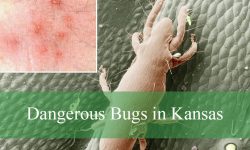I can’t stop watching the beautiful butterflies in my neighborhood dance! It is incredibly fascinating to see the wide range of hues, patterns, and sizes.
Ohio is home to a myriad of butterfly species, numbering in the hundreds. Attempting to catalogue them all in a single article would be a daunting task, so I’ve opted to spotlight the most prevalent and enthralling ones for your exploration.
Come along with me as we explore the world of Ohio’s forty-three fascinating species of butterflies.
Different types of butterflies are found in Ohio
Least Skipper
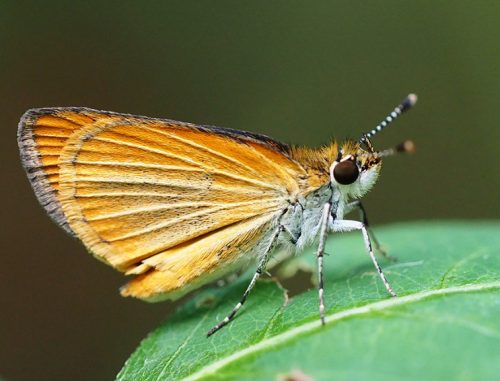
The Ancyloxypha Numitor, also known as the Least Skipper, has 0.75–1 inch wingspan, dark brown color, and prominent orange patches on the upper wings. They are common in the wet, open areas of Ohio. They lay their eggs on the blades of grass in grassy habitats such as fields, ditches, streams, and marshes. Larvae that have just hatched roll themselves inside the grass to find cover. Male Least Skippers are constantly patrolling grassy areas in search of females to mate with. But sometimes, females will drop and place their wings beneath their bodies to reject advances.
Pipevine Swallowtail
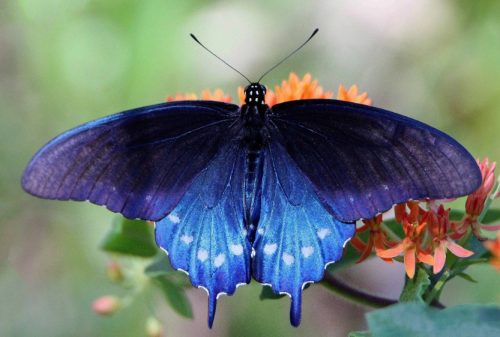
The Pipevine Swallowtail, or Battus Philenor, has wingspans of two to three inches. It is primarily black with bright blue edges and orange-white spots underneath. Vivacious in Ohio, they graze on pink and purple flowers, such as Phlox, to obtain nectar. The females lay their eggs on the undersides of host plants, usually those in the Aristolochia family, like Virginia Snakeroot and Dutchman’s pipe, after the males actively pursue them for mating. These butterflies, like other species, have a defense mechanism that makes them unappealing to predators.
Sachem
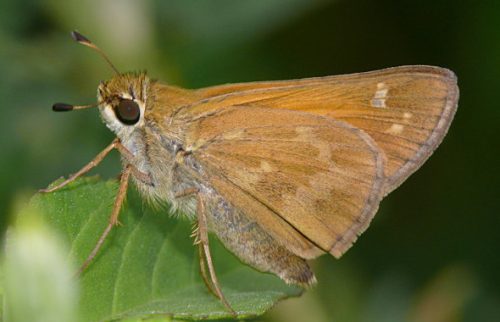
The Sachem, or Atalopedes Campestris, has wingspans of one to one and a half inches. The males have shadowy yellow hindwings with a characteristic brown area and pale spots, and dull orange forewings with brown edges. The female’s hindwings are brown with V-shaped pale spots, and her forewings are dark brown with orange centers, black patches, and white windows.
Prosperous in bright, open spaces like fields, pastures, suburban lawns, and gardens, males take on a passive role in mating, perching on or close to the ground until females select them. Following mating, females deposit their eggs on dry grass blades, and the caterpillars hide inside leaves to keep themselves safe while consuming the blades of grass. Lepidopterists refer to Sachems, Whirlabouts, and Fiery Skippers as the “three wizards” in jest because of their whirling flight patterns.
Common Checkered-Skipper
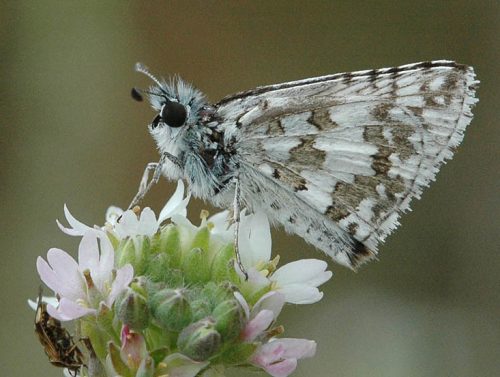
Burnsius Communis, commonly known as the Common Checkered-Skipper, has 0.75–1.25 inch wingspan, with faded white coloration, tan stripes, and a brown or black hindwing edge. Interestingly, from above, they have a unique checkered pattern in black and white. This butterfly, which is often observed in Ohio, prefers mallow as its main host plant. It grows well in pastures, open fields, and disturbed areas and is usually found close to roads. Pale green eggs are laid on the soft sections of the host plant after males actively search for suitable females to mate with. After hatching, caterpillars devour their host plant and curl their leaves to protect themselves from the cold.
Little Sulphur
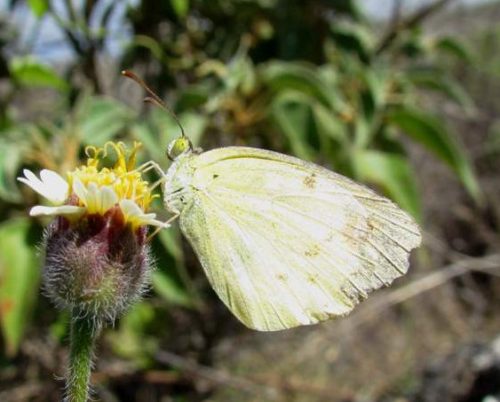
The Eurema lisa, also known as the Little Sulphur, has wingspan of one to one and a half inches. Males have bright yellow wings with black tips or borders, while females have pale yellow wings with dark specks. Their caterpillars have thin cream stripes on each side and a deep green color.
They are often found in disturbed open spaces in Ohio, including trails, empty lots, and roadside areas. Known as Little Yellows, they use partridge pea as a host plant for their caterpillars and are drawn to nearby aster varieties for nectar. Although they are year-round in warm climates, in northern regions they are usually sighted from late June to early October.
Checkered White
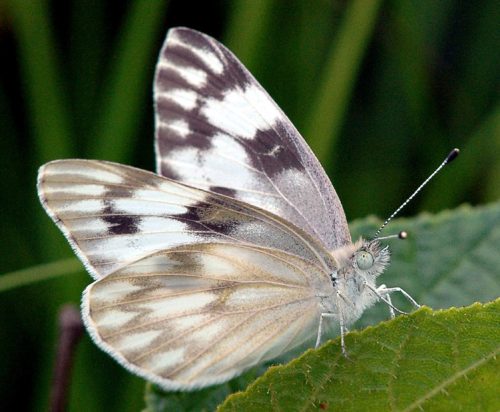
The scientific name for Checkered Whites is Pontia Protodice, and they have 1-2 inch wingspans. Males have dark grey markings, females have checkered fore- and hindwing patterns. They are notable for using UV signals for mate selection and communication. Larvae exhibit a preference for flowers or fruits, and females deliberately deposit their eggs on the fruits or stems of their host plants. These butterflies, which are common in Ohio, like sunny, open spaces like plains, dry grasslands, and deserts. They also do well in man-made places like railroads and airports.
Horace’s Duskywing
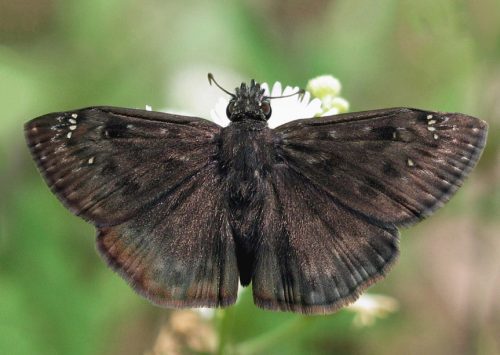
The wingspans of Horace’s Duskywings, or Erynnis Horatius, range from 1.5 to 1.75 inches. Men are mostly dark brown with white and yellow undertones, and females are lighter brown with large spots. They can be distinguished by their quick, darting flight, which is common in sunny dirt roadside spots, oak woodlands, and open fields. Approximately one foot above the ground, male butterflies perch on slopes to await females. The last brood of caterpillars hibernates through the winter, so they are among the first to be seen in the spring. They build leaf nests and feed on saplings.
Peck’s Skipper
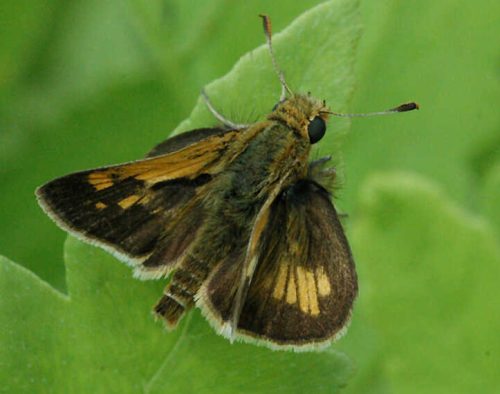
Peck’s Skipper, formally known as Polites Peckius, has wingspans of 1.25 to 1.75 inches. Females are usually darker and can be identified by their yellow-spotted hindwings over a dark brown base with reddish-orange patches from above. These skippers prefer open areas with lots of sunlight and nectar-producing flowers, such as meadows, parks, prairies, and vacant lots in Ohio. With their hindwings down and their forewings open, males lounge in the sun, hoping to attract a partner. The female lays her eggs singly on host plants during the day, and the caterpillars eat grasses such as rice cutgrass and bluegrass.
Zabulon Skipper
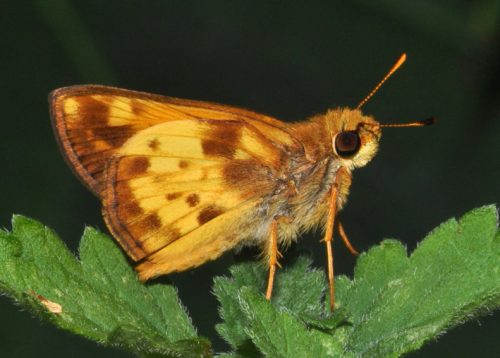
The Zabulon Skipper, also known as Lon Zabulon, has unique features like brown-edged wings and hindwings that are yellowish-orange in color. Its wingspan is 1-1.5 inches. While females have purplish black and brown bases with yellow and white angular spots and a zigzag pattern, males have yellow hues with hints of orange and a dark brown border from above.
They are common in Ohio, where they can be found growing along roadside edges, in the margins of streams, and in parks and suburban areas. Males typically court females in the afternoon or sometimes early in the morning while waiting for them perched on branches or flowers. In their vast habitat, female zambon skippers lay their eggs singly on the underside of the leaves of their host plants, serving as vital pollinators for a variety of plant and flower species.
Zebra Swallowtail
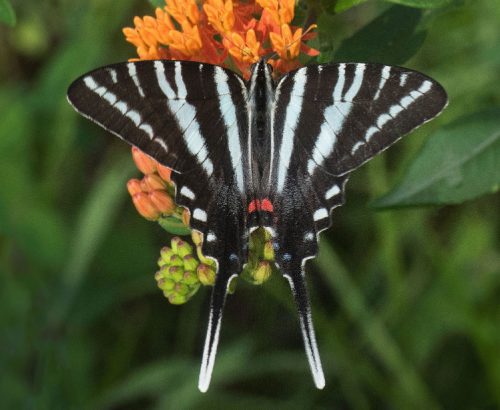
The Eurytides Marcellus, or zebra swallowtail, has striking red body patches and stripes on the hindwings, and it has 2.5 to 3.5 inch wingspans. Spring specimens have bolder white patterns, while summer specimens are black with white bars resembling zebras. Adored by enthusiasts, they are often found in Ohio’s pawpaw-rich riversides, swamps, and broadleaf woodlands; they also sometimes stray into open fields in search of nectar. Their caterpillars have a covert defense mechanism despite their beauty. To ward off predators, the Osmeterium, an orange gland, releases a potent stench.
Eastern Giant Swallowtail
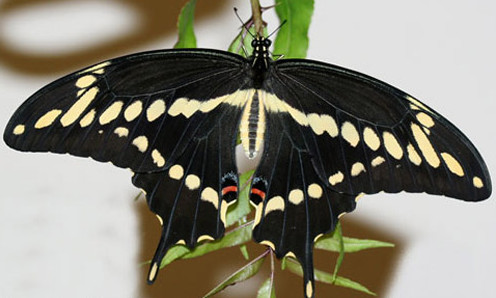
The Eastern Giant Swallowtail, or Heraclides Cresphontes, has wingspans of 4–6.5 inches and is colored from dark brown to black above with yellow highlights. Their size and striking appearance make them a delightful backyard sight. They thrive in Ohio and are often found in flower-rich meadows, suburban gardens, and deciduous forests. Near host plants, males actively search for females through courtship displays prior to mating. The tips of the leaves are where females deposit their eggs. Larvae have the appearance of tiny brown snakes and use an Osmeterium, which is an orange-red structure that resembles a snake’s tongue and releases an offensive stench when disturbed.
Silver-Spotted Skipper
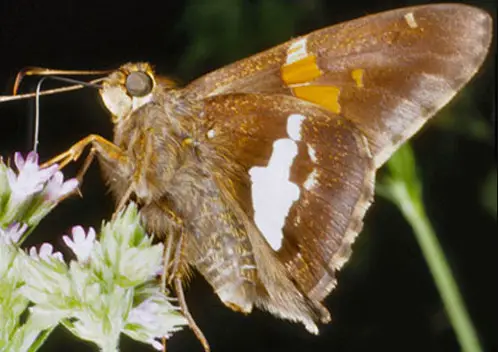
Epargyreus clarus, commonly known as the Silver-Spotted Skipper, has wingspans of 1.75 to 2.25 inches and a noticeable silver patch on the middle of its hindwing. Growing abundantly in Ohio, they have a varied diet, using their long tongues to eat flowers, mud, and sometimes even animal droppings. Usually seen near forest edges that are rich in nectar, males perch atop tall vegetation and perform jerky flights in order to court females. Females lay eggs on host plants after mating. Using creative leaf-cutting methods, caterpillars create silk-bound tubes for protection during the day, and go outside to feed at night. Caterpillars scatter their scent and release a defensive green chemical to disorient predators when they feel threatened.
Cloudless Sulphur
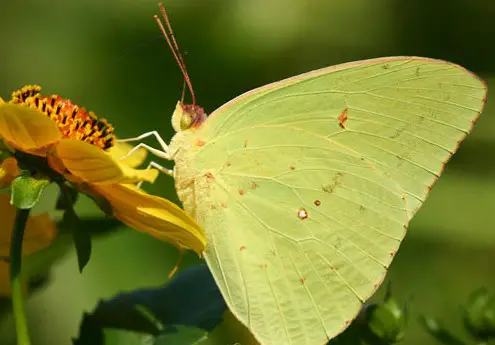
The Phoebis sennae, also known as the Cloudless Sulphur, has a bright lemon-yellow wingspan of 2.2–2.8 inches when unmarked. Easily identifiable in Ohio, they flourish freely and don’t seem shy of people. Their upper wings are primarily pure yellow, but they can have small white eyespots rimmed in dark red. Their population has been impacted by habitat loss due to overdevelopment, even though they are not considered threatened. You can help attract these happy butterflies and support their conservation efforts by planting native flowers.
Clouded Sulphur
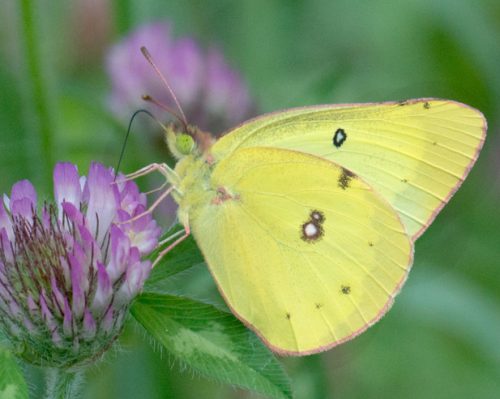
Colias philodice, also known as the Clouded Sulphur, has two distinct color forms: a yellow form and a white form with a light green tint. Its wingspan ranges from 1.75-2.75 inches. Both types have pinkish wing borders and an eyespot surrounded in red. They can adapt to a variety of habitats and are common in Ohio, where they can be found in parks, gardens, and roadsides. They can be distinguished by their unpredictable, unsteady flight, and they inhabit the same habitat as their relatives, the Orange Sulphur, who are known for their jerky flying style. It’s interesting to note that male Clouded Sulphurs always remain yellow, and only females display the white morph.
Orange Sulphur
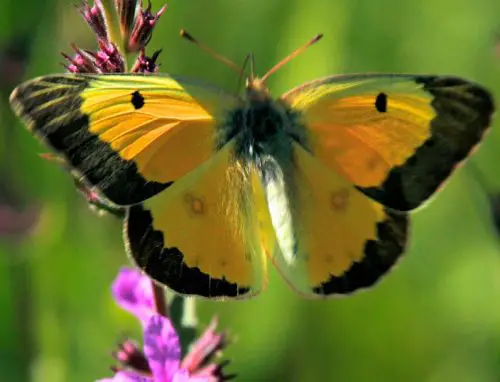
The 1.5–2.5 inch wingspan of the Orange Sulphur, or Colias eurytheme, is enhanced by irregular spots and black wing borders. Its vivid yellow-orange coloring is also noticeable. Their common habitats in Ohio are sunny meadows, gardens, and roadsides. They feed on the host plant, alfalfa, and deposit their eggs there, hence their moniker, “Alfalfa butterfly.” They can be easily identified by their low, irregular, jerky flight. During the spring and summer, urban and suburban areas are common places to see them.
Cabbage White
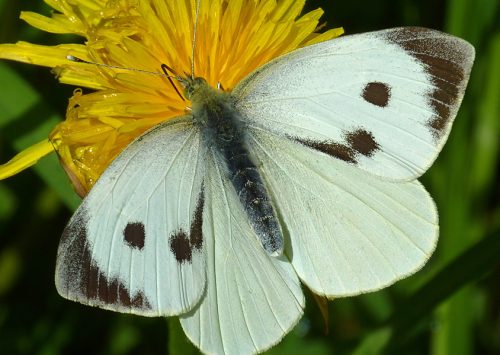
The Cabbage White, or Pieris rapae, has light green to white wings with black tips and dots, and its wingspan is 1.25 to 2 inches. They thrive even in big cities and are nimble in a variety of Ohio habitats, avoiding dense forests. Their caterpillars, also called Cabbage Worms, are active in the summer and can be dangerous to brassica plants such as kale and cabbage. Since they were brought to the area through the food and agricultural trade, they have become one of the most damaging species to crops, so careful plant protection is necessary due to their invasive nature.
Spicebush Swallowtail
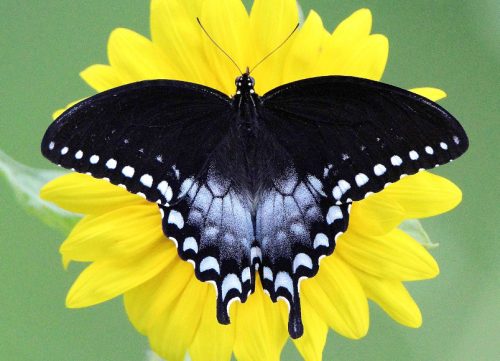
The 3–4 inch wingspan of the Spicebush Swallowtail, or Papilio troilus, is characterized by cream-colored wing edge spots and greenish-blue or bright blue hindwing patches. They are active from late spring to early fall, and they thrive in forests, swamps, and abandoned fields. Use jewelweed or azaleas to entice them with nectar. Their caterpillars, which are easily recognizable, prefer white sassafras and spicebush. Unlike other Ohio swallowtails, they are notable for their ability to control body temperature, which allows them to be active in colder climates.
Pearl Crescent
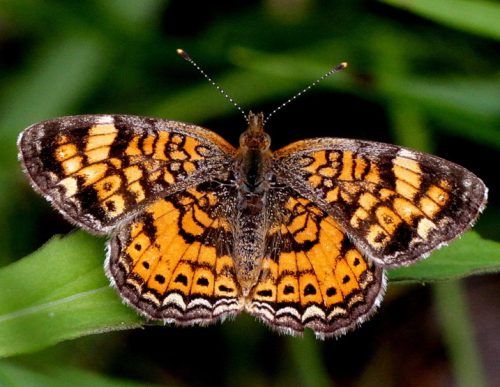
The 1.25–1.75″ wingspan of the Pearl Crescent, or Phyciodes tharos, are distinctive due to their rich black lace-like patterns set against a vivid orange background. Look for them in areas with damp ground, such as gardens, fields, meadows, and the edges of forests. Aster plants are a great addition to any butterfly-friendly garden, as their caterpillars love them.
Mourning Cloak
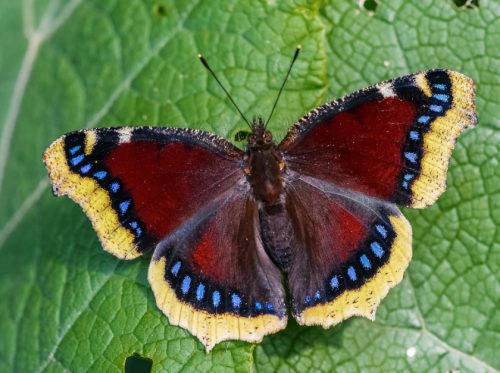
Nymphalis Antiopa, also known as the Mourning Cloak, has striking black wings with an iridescent sheen, accentuated by purple spots and a yellow border. Its wingspan is 3–4 inches. They are adaptable but a little elusive because of their habitat, which includes parks and suburban yards in addition to deciduous forests. They are among the species of butterflies with the longest lifespans, having been known to withstand harsh winters and live for up to 10 months.
Red-Spotted Purple
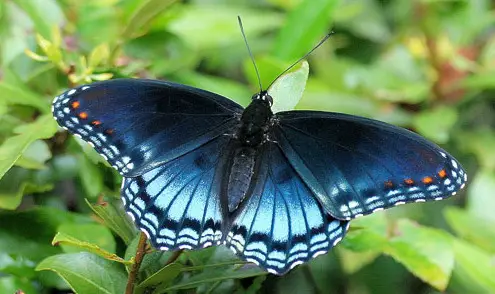
The Red-Spotted Purple, also known as Limenitis arthemis astyanax, resembles the poisonous Pipevine Swallowtail with its iridescent blackish-blue coloring and red-orange spots on its 4-5 inch wings. These stunning butterflies come in many different forms, one of which is the White Admiral found in the north. During their active season, which runs from April to October, carrion, sap, and rotting fruit are excellent lures for them.
Hackberry Emperor
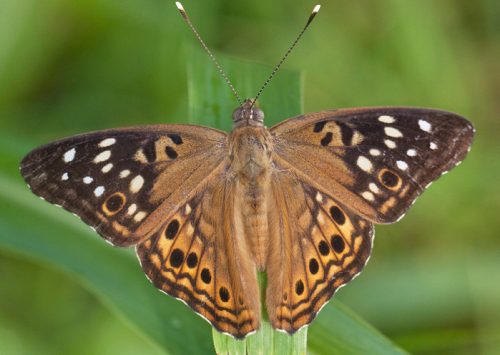
Asterocampa celtis, also known as the Hackberry Emperor, is a bird with a 2-2.75-inch wingspan. Its pattern is a striking amber brown and almost black, with orange-ringed eyespots. These inquisitive butterflies steer clear of flowers in favor of minerals from rocks, soil, and pavement as well as sodium from human skin. They also drink water from rain puddles and feed on rotting fruit, carrion, sap, and dung.
Viceroy
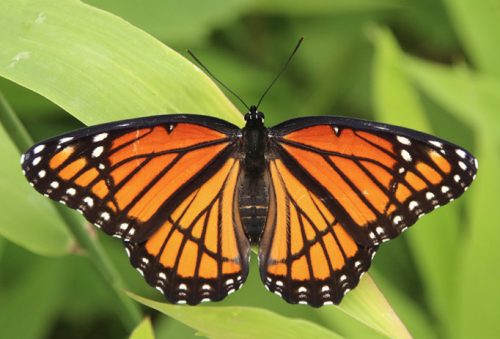
Viceroys, or Limenitis archippus, are distinguished by their deep orange color, black veins and edges, and a 2.5–3.25 inch wingspan. To tell them apart from monarchs, look for the black line on the underside of the wing. Viceroy caterpillars hibernate in rolled-up leaves and reappear during the following breeding season. They have a spiky, greenish-brown appearance.
Eastern Tiger Swallowtail
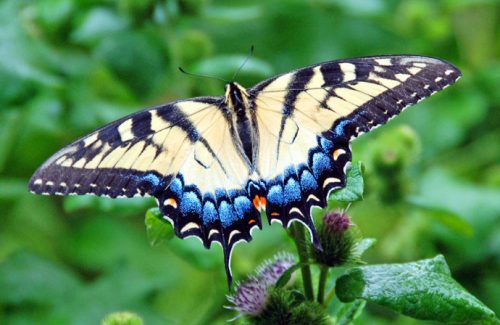
The wingspan of the Eastern Tiger Swallowtail, or Papilio glaucus, is 3.5–5.5 inches. The males have bright yellow colors with black borders and stripes, and the females have two color variations: the light yellow color with darker black markings, and the dark nearly black color with light blue dots on the underwing. Well-known for its remarkable appearance, this lone flyer is common in Ohio and is sometimes observed in groups of males “puddling” on damp ground. They can be drawn to home gardens by planting tall-stalked flowers such as lilac, ironweed, and phlox. Interestingly, the caterpillar uses an enlarged head and noticeable eyespots to imitate a menacing snake in order to scare off potential predators.
Black Swallowtail
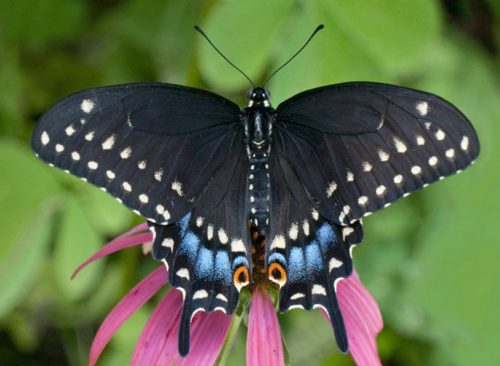
With a wingspan of 2.5–4.25 inches, the Black Swallowtail, also known as Limenitis archippus, is characterized by black coloring with rows of light yellow spots, a reddish-orange eyespot, and blue spots on each hindwing. They are common in Ohio gardens, frequently visiting plants and favoring the nectar of flowers. Their green caterpillars may be dangerous if they feed too much because they feed on domesticated herbs like mint and parsley. Through evolved mimicry, they can effectively evade predators by resembling the toxic Pipevine Swallowtail.
Banded Hairstreak
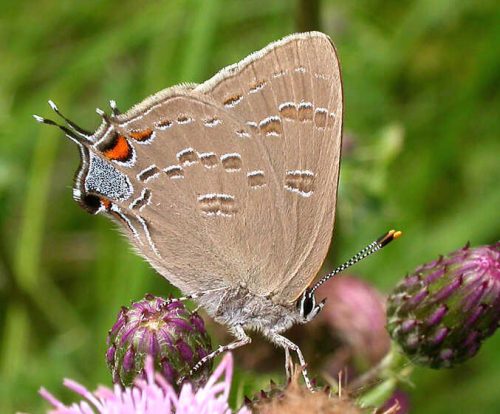
Satyrium calanus, also known as the Banded Hairstreak, has wingspan of 1 to 1.25 inches. Its colors range from brown to slate gray, and it has black-bordered red dots along the outer edges of its wings, white stripes, and a blue patch close to its wing tips. Their usual habitats are sunny clearings or wooded areas close to trees. They are attracted to nectar plants, which facilitates their sightings in the vicinity of trees. Adding meadowsweet or dogbane to your landscape will draw them in more. They mate once during their roughly four-week-long active period in the early summer, and the eggs they lay survive the summer, fall, and winter before hatching into caterpillars in the spring. Search the areas around hickory, walnut, and oak trees for them.
Gray Hairstreak

Strymon melinus, commonly known as the Gray Hairstreak, has wingspan of one to one and a half inches. Its colors are slate gray, with one bright orange spot on each lower wing. Interestingly, they have light gray underwings with a black and white stripe. They are typically found in open spaces like roadside ditches, abandoned pastures, and rural meadows. Their caterpillars feed on a variety of plants and are able to thrive in a variety of environments. With their long, thin wing tails that resemble hairs, they use this adaptation to their advantage by drawing predators’ attention away from their bodies. By imitating a head and using eyespots as a means of distraction, the Gray Hairstreak gains enough time to flee from possible threats.
Eastern Tailed-Blue
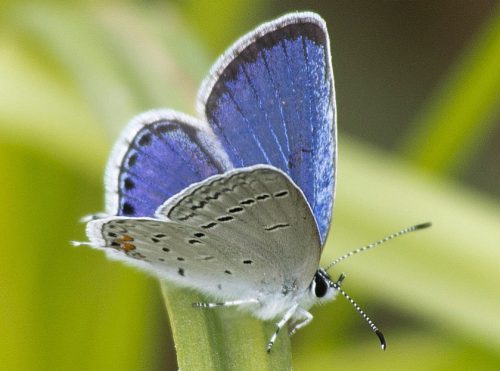
The Eastern Tailed-Blue, or Cupido comyntas, has a wingspan of 0.75 to 1 inch. The males have brilliant blue colors with white edges and a brown border, while the females have grayish-brown colors with white edges. One or two tiny orange spots are present above the wing tails in both genders. They are one of the most common species and are attracted to flowers, making them easy to spot in Ohio’s gardens, pastures, and empty lots. Their silvery-blue underside and delicate, hair-like tails on the hindwings, which frequently break off, are two of their defining characteristics.
American Snout
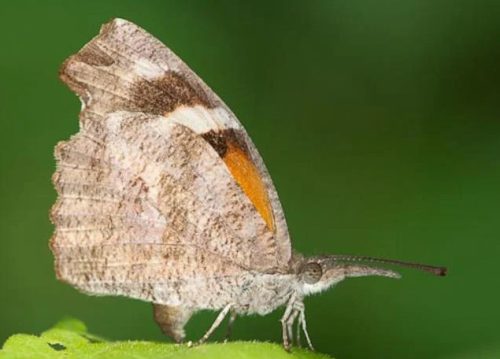
Libytheana carinenta, also known as the American Snout, has a wingspan of 1.5 to 2 inches and is brown in color with orange and white patches that resemble dead leaves. Its unusually long, beak-like “snout” acts as a leaf-like disguise. Unlike anything else in Ohio, this special quality helps keep it hidden. Even though they migrate north every year, their outstanding camouflage makes them rare and difficult to spot. Sometimes sightings of massive migratory groups cause the sky to darken.
Little Wood Satyr
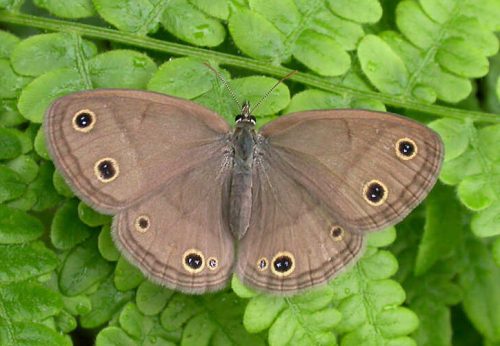
Megisto cymela, also known as the Little Wood Satyr, has a wingspan of 1.5 to 1.9 inches and is brown in color with several yellow-ringed eyespots. They are frequently found in clearings, nearby brushy areas, and shaded woodlands. They favor lower perches, such as leaf litter, over branches and tall grass. Because of their diet, they don’t seek out flowers like other butterflies do. Rather, they are drawn to old sap flows, rotting mushrooms, and animal dung. Instead of trying to draw this species to your yard, it’s preferable to watch it in its natural environment.
Common Wood-Nymph
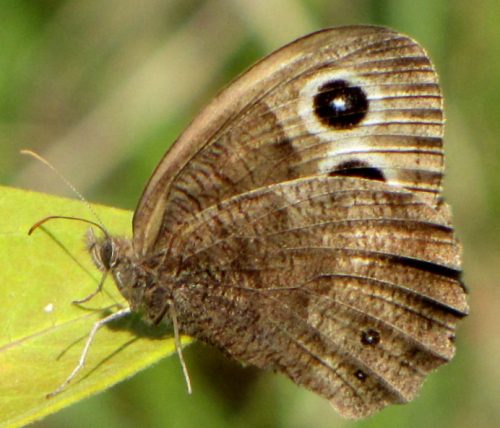
With a wingspan of two to three inches, the Common Wood-Nymph, or Cercyonis pegala, is usually brown with dark eyespots. It inhabits a variety of environments, such as salt marshes, meadows, open forests, and agricultural fields. Their caterpillars emerge in the latter part of fall, hibernate over the winter, and consume grass, especially Kentucky Bluegrass. They are busiest in the late summer and early fall. They like decaying plants or rotting fruit, though they do occasionally eat flower nectar. You might not need to plant anything new to draw this species because they prefer a common lawn grass.
Silver-Bordered Fritillary
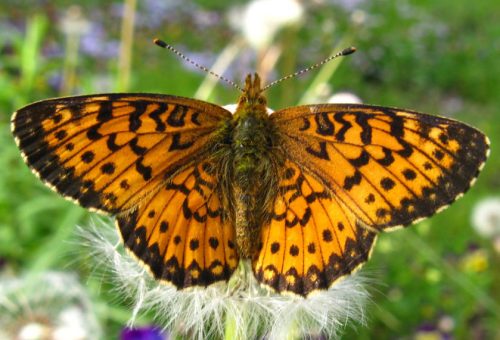
Boloria selene, also known as the Silver-Bordered Fritillary, has a 1.6–2.1 inch wingspan, vivid orange colors, and sporadic black markings along the edge. The thick black border around its wings is adorned with orange dots and metallic silvery dots on the underside. This species, which favors moist grasslands, is in danger of going extinct because agricultural fields are disrupting its habitat. Plant thistle for nectar and violets for their caterpillars to draw them in. Watch the ground for their quick, low flights, which are orange in streaks.
Meadow Fritillary
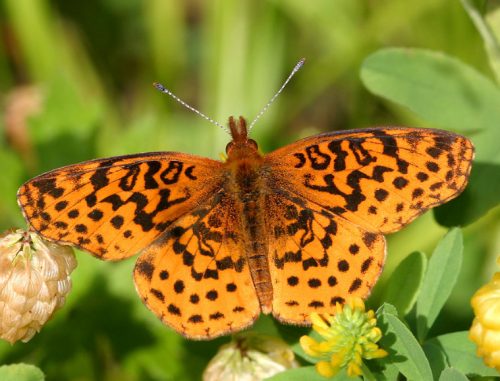
Boloria bellona, also known as the Meadow Fritillary, has wingspan of 1.5 to 2 inches and yellow-orange coloration with dark black spots. Its muted underside helps with camouflage, as it resembles a dead leaf. Throughout the summer, this brush-footed butterfly can be found frequently in eastern Ohio. Consider adding aster flowers to your garden, such as daisies, sunflowers, and Black-eyed Susans, to draw them in.
Great Spangled Fritillary
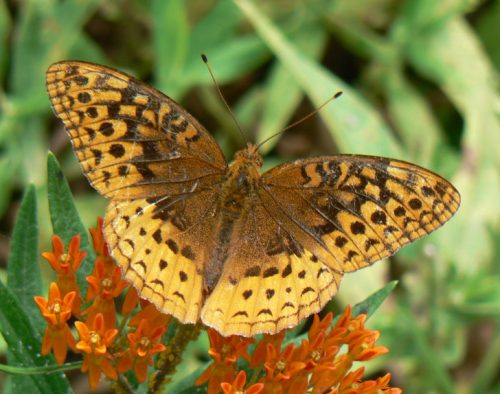
The Great Spangled Fritillary, also known as Speyeria cybele, is an orange-colored butterfly with a 2.5–3.5 inch wingspan and a unique black line and dot pattern resembling a web. It prefers sunny, open spaces like pastures and meadows, where it can be found in large groups around fields of violets or milkweed. Caterpillars in this non-migratory species hibernate during the winter and emerge in the springtime along with the new growth of their host violet plants. Males usually die a few weeks before females do, after mating, after the females feed for a few weeks before laying eggs and dying as well.
Variegated Fritillary
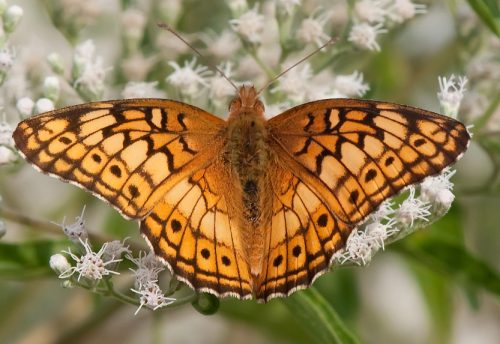
Euptoieta claudia, also known as the Variegated Fritillary, has a wingspan of 1.75 to 2.25 inches and a tawny brown to burnt orange coloration that is denoted by black dots and lines. Search Ohio’s fields, open spaces, and meadows for them. Plant flowers like sunflowers, mint, and butterfly weed to draw them to your garden. Their caterpillars will find host plants like violets, pansies, and passionflower. The chrysalis of the Variegated Fritillary is an amazing sight, with its pearly white color and shiny gold spikes resembling an exquisite jeweled pendant.
Common Buckeye
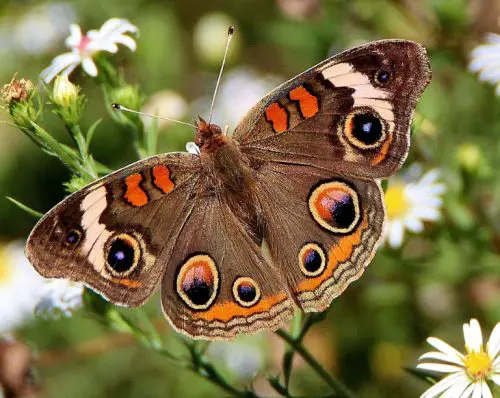
With a wingspan of two to three inches, the Common Buckeye, or Junonia coenia, is characterized by its brown coloring, unique orange bars, and striking black and white rings that delineate multiple prominent eyespots. Seek them out in Ohio’s open areas, such as roadsides, pastures, and abandoned fields. Although they fly low to the ground and are difficult to approach, they frequently perch for good photo ops. The climate in the southern United States allows Common Buckeyes to breed year-round, so they don’t follow a set mating season. In contrast, they travel south for the winter and come back in the spring in the northern states, giving birth to two to four generations every season.
Eastern Comma
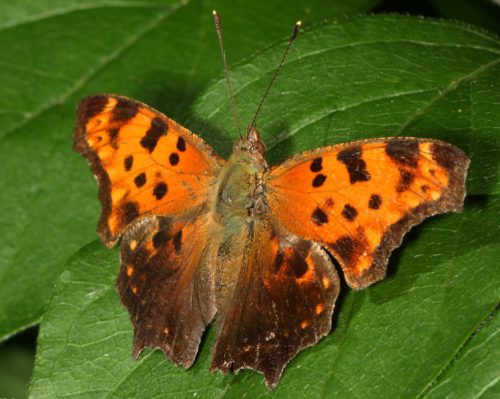
The Eastern Comma, also known as the Polygonia comma, has 2-2.5 inches of wingspan. Its upper wings are orange-colored with black mottling, while its lower wings are mostly black with some orange spots. They live in parks, suburban yards, and deciduous forests; elm and nettle trees are the caterpillars’ favorite hosts. Adults eat decaying fruit, carrion, and animal waste instead of being drawn to flowers. In spite of their unattractive diet, they are fairly common and easily identifiable. It’s interesting to note that adult Eastern Commas hibernate, spending the winter months in tree hollows, log piles, and even man-made buildings. Early spring is when they mate, and early summer is when the young start to behave.
Question Mark
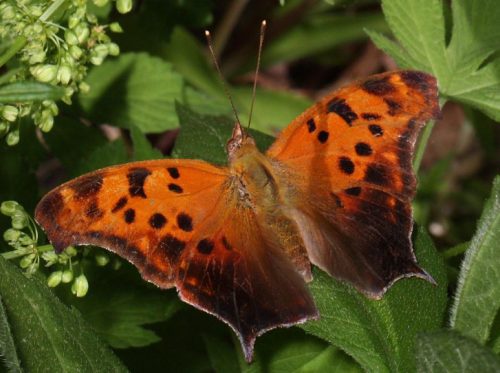
The Question Mark, or Polygonia interrogationis, has a deep orange color, black spots, and a lavender edge. Its wingspan is 2.25 to 3 inches. They are found in damp forests and their margins, especially in areas where nettles and elm trees are prevalent. Their underside is mottled brown, which contrasts with their bright upperwing coloration to provide effective leaf-like camouflage. Their interesting name comes from a faint imprint on the bottom that looks like a crude question mark.
American Lady

In open landscapes in Ohio, look for American Lady butterflies with a wingspan of 1.75 to 2.5 inches close to flowering plants. They have defense mechanisms in the form of dark borders, eyespots, and brilliant orange coloring. These tense butterflies are ready to fly at the first hint of trouble.
Monarch
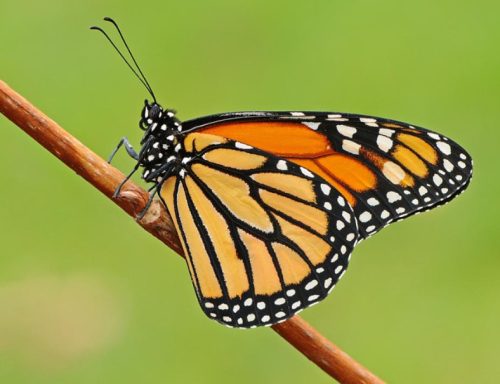
Look for Monarch butterflies, which have a wingspan of 3.5–4 inches, in Ohio. Their recognizable milkweed dependence, white dots, and stained-glass pattern are well-known. Other pollinators can also gain from planting milkweed to support monarch butterflies, particularly when they are migrating in mid-September.
Painted Lady
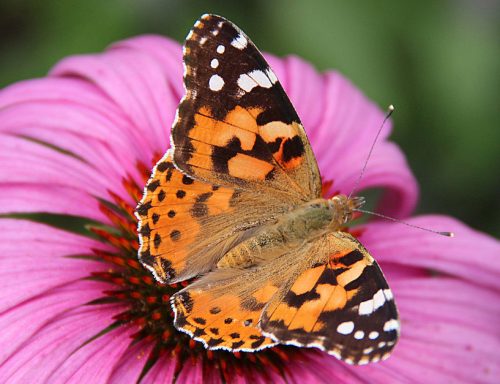
With a wingspan of 1.75 to 2.5 inches, Ohio’s Painted Lady butterflies migrate to Mexico for the winter. They can adapt and are frequently seen in different quantities. Their migration pattern influences their unusual year-round mating behavior. Seek them out in untouched, wide spaces.
Red Admiral
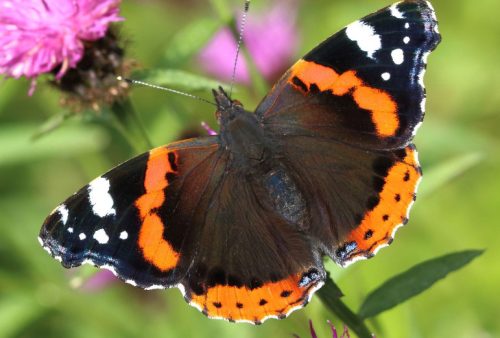
The Red Admiral, a common Ohio butterfly, has a wingspan of 1.75 to 2.5 inches. Seek it out in wet areas and along the edges of forests. They have a distinct migratory pattern, traveling south in the winter and north again in the late spring, and they like fermented fruit. They frequently land on people and are friendly and serene.
People Who Read This Also Read:


